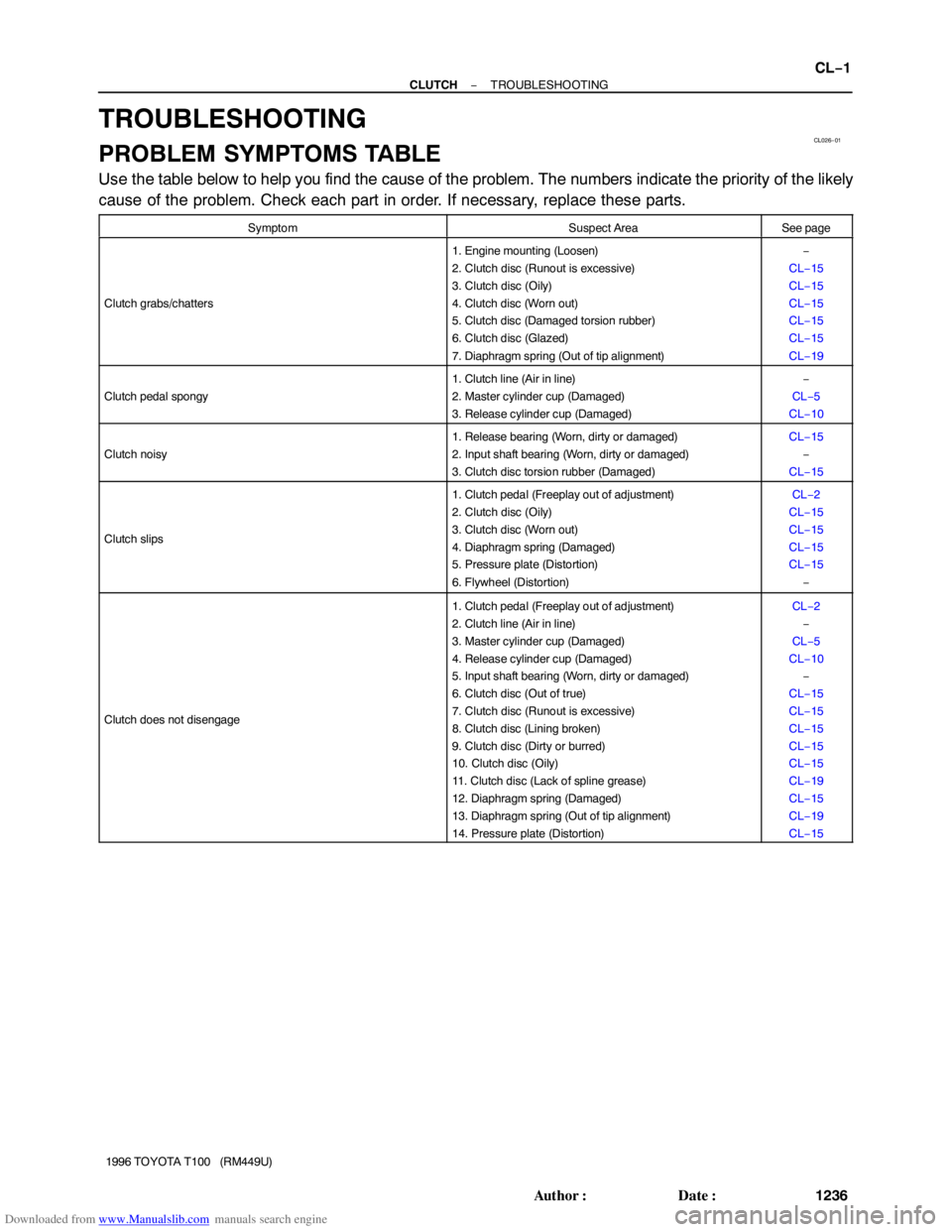Page 1257 of 2062
Downloaded from www.Manualslib.com manuals search engine P13543
B05826
Push
P13397
P13571
− CHARGING (5VZ−FE)GENERATOR
CH−15
1996 TOYOTA T100 (RM449U)
(c) Install the 5 screws until there is a clearance of approx. 1
mm (0.04 in.) between the brush holder and voltage regu-
lator.
Torque: 2.0 N·m (20 kgf·cm, 17 in.·lbf)
(d) Fit the brush holder cover.
7. INSTALL REAR END COVER
(a) Install the end cover with the 3 nuts.
Torque: 4.5 N·m (46 kgf·cm, 40 in.·lbf)
(b) Install the terminal insulator with the nut.
Torque:4.1 N·m (42 kgf·cm, 36 in.·lbf)
8. CHECK THAT ROTOR ROTATES SMOOTHLY
Page 1258 of 2062
Downloaded from www.Manualslib.com manuals search engine CH02O−02
CH−16
− CHARGING (5VZ−FE)GENERATOR
1996 TOYOTA T100 (RM449U)
INSTALLATION
Installation is in the reverse order of removal (See page CH−6).
Page 1259 of 2062
Downloaded from www.Manualslib.com manuals search engine CL – CLUTCH
TROUBLESHOOTING CL-1
CLUTCH PEDAL CL-2
CLUTCH MASTER CYLINDER CL-5
CLUTCH RELEASE CYLINDER CL-10
CLUTCH UNIT CL-15
Page 1260 of 2062

Downloaded from www.Manualslib.com manuals search engine CL026−01
− CLUTCHTROUBLESHOOTING
CL−1
1236 Author�: Date�:
1996 TOYOTA T100 (RM449U)
TROUBLESHOOTING
PROBLEM SYMPTOMS TABLE
Use the table below to help you find the cause of the problem. The numbers indicate the priority of the likely
cause of the problem. Check each part in order. If necessary, replace these parts.
SymptomSuspect AreaSee page
Clutch grabs/chatters
1. Engine mounting (Loosen)
2. Clutch disc (Runout is excessive)
3. Clutch disc (Oily)
4. Clutch disc (Worn out)
5. Clutch disc (Damaged torsion rubber)
6. Clutch disc (Glazed)
7. Diaphragm spring (Out of tip alignment)−
CL−15
CL−15
CL−15
CL−15
CL−15
CL−19
Clutch pedal spongy
1. Clutch line (Air in line)
2. Master cylinder cup (Damaged)
3. Release cylinder cup (Damaged)−
CL−5
CL−10
Clutch noisy
1. Release bearing (Worn, dirty or damaged)
2. Input shaft bearing (Worn, dirty or damaged)
3. Clutch disc torsion rubber (Damaged)CL−15
−
CL−15
Clutch slips
1. Clutch pedal (Freeplay out of adjustment)
2. Clutch disc (Oily)
3. Clutch disc (Worn out)
4. Diaphragm spring (Damaged)
5. Pressure plate (Distortion)
6. Flywheel (Distortion)CL−2
CL−15
CL−15
CL−15
CL−15
−
Clutch does not disengage
1. Clutch pedal (Freeplay out of adjustment)
2. Clutch line (Air in line)
3. Master cylinder cup (Damaged)
4. Release cylinder cup (Damaged)
5. Input shaft bearing (Worn, dirty or damaged)
6. Clutch disc (Out of true)
7. Clutch disc (Runout is excessive)
8. Clutch disc (Lining broken)
9. Clutch disc (Dirty or burred)
10. Clutch disc (Oily)
11. Clutch disc (Lack of spline grease)
12. Diaphragm spring (Damaged)
13. Diaphragm spring (Out of tip alignment)
14. Pressure plate (Distortion)CL−2
−
CL−5
CL−10
−
CL−15
CL−15
CL−15
CL−15
CL−15
CL−19
CL−15
CL−19
CL−15
Page 1261 of 2062

Downloaded from www.Manualslib.com manuals search engine Q02464
Push Rod Play Adjust Point
Pedal Height
Adjust Point
Pedal Height
Push Rod
PlayCL027−01
CL0102Pedal Freeplay CL−2
− CLUTCHCLUTCH PEDAL
1237 Author�: Date�:
1996 TOYOTA T100 (RM449U)
CLUTCH PEDAL
INSPECTION
1. CHECK THAT PEDAL HEIGHT IS CORRECT
Pedal height from floor panel:
154.6 − 164.6 mm (6.087 − 6.480 in.)
Pedal height from asphalt sheet:
Extra Cab (4WD): 150.1 − 160.1 mm (5.909 − 6.303 in.)
Others: 153.1 − 163.1 mm (6.027 − 6.421 in.)
2. IF NECESSARY, ADJUST PEDAL HEIGHT
Loosen the lock nut and turn the stopper bolt until the height is
correct. Tighten the lock nut.
3. CHECK THAT PEDAL FREEPLAY AND PUSH ROD
PLAY ARE CORRECT
�Push in on the pedal until the beginning of clutch resis-
tance is felt.
Pedal freeplay: 5.0 − 15.0 mm (0.197 − 0.591 in.)
�Gently push on the pedal until the resistance begins to in-
crease a little.
Push rod play at pedal top:
1.0 − 5.0 mm (0.039 − 0.197 in.)
4. IF NECESSARY, ADJUST PEDAL FREEPLAY AND
PUSH ROD PLAY
(a) Loosen the lock nut and turn the push rod until the free-
play and push rod play are correct.
(b) Tighten the lock nut.
(c) After adjusting the pedal freeplay, check the pedal height.
(d) Connect the air duct and install the lower finish panel.
5. CHECK CLUTCH RELEASE POINT
(a) Pull the parking brake lever and install wheel stopper.
(b) Start the engine and idle the engine.
(c) Without depressing the clutch pedal, slowly shift the shift
lever into reverse position until the gears contact.
Page 1262 of 2062

Downloaded from www.Manualslib.com manuals search engine CL0512
25 mm (0.98 in.) or more
Release
Point
Full Stroke
End Position
Q02465
Clutch
Start Switch
Q00617
8 ± 0.5 mm
(0.31 ± 0.020 in.)
− CLUTCHCLUTCH PEDAL
CL−3
1238 Author�: Date�:
1996 TOYOTA T100 (RM449U)
(d) Gradually depress the clutch pedal and measure the
stroke distance from the point the gear noise stops (re-
lease point) up to the full stroke end position.
Standard distance:
25 mm (0.98 in.) or more
(From pedal stroke end position to release point)
If the distance not as specified, perform the following operation.
�Check pedal height.
�Check push rod play and pedal freeplay.
�Bleed the clutch line.
�Check the clutch cover and disc.
6. CHECK CLUTCH START SYSTEM
(a) Check that the engine does not start when the clutch ped-
al is released.
(b) Check that the engine starts when the clutch pedal is fully
depressed.
If necessary, replace the clutch start switch.
7. CHECK CONTINUITY OF CLUTCH START SWITCH
Check the continuity between terminals when the switch is ON
and OFF.
Switch positionCondition
ON (pushed)Continuity
OFF (free)No Continuity
If continuity is not as specified, replace the switch.
Page 1263 of 2062

Downloaded from www.Manualslib.com manuals search engine Z17110
No continuity
Z17111
No continuity
Z17112No continuity
CL0363
Continuity
CL0364
No continuity CL−4
− CLUTCHCLUTCH PEDAL
1239 Author�: Date�:
1996 TOYOTA T100 (RM449U)
8. CHECK CONTINUITY OF CLUTCH START CANCEL
SWITCH
(a) Check that there is no continuity when connecting the
positive (+) lead from the ohmmeter to terminal 2 and the
negative (−) lead to terminal 1.
(b) Check that there is no continuity when connecting the
positive (+) lead from the ohmmeter to terminal 3 and the
negative (−) lead to terminal 1.
(c) Check the there is no continuity between terminals 2 and
3.
If continuity is not as specified, replace the clutch start cancel
switch.
9. CHECK OPERATION OF CLUTCH START CANCEL
SWITCH
(a) Connect positive (+) lead from the battery to terminal 3
and connect negative (−) lead to terminal 1.
(b) Check that there is no continuity when connecting the
positive (+) lead from the ohmmeter to terminal 2 and the
negative (−) lead to terminal 1.
(c) When pushing the switch, check that the indicator light
connect on and there is continuity between terminal 1 and
2.
(d) Check that there is no continuity between terminals 1 and
2 when disconnect the battery lead.
If continuity is not as specified, replace the clutch start cancel
switch.
Page 1264 of 2062
Downloaded from www.Manualslib.com manuals search engine CL028−03
Q07730
Filler Cap
FloatClevis
Clip
Snap Ring
Push Rod
Pin
Lock Nut
Boot
Washer
Piston
Spring
� Non−reusable partClutch Line Master Cylinder Slotted Spring PinReservoir Tank
� Grommet
Body
− CLUTCHCLUTCH MASTER CYLINDER
CL−5
1240 Author�: Date�:
1996 TOYOTA T100 (RM449U)
CLUTCH MASTER CYLINDER
COMPONENTS